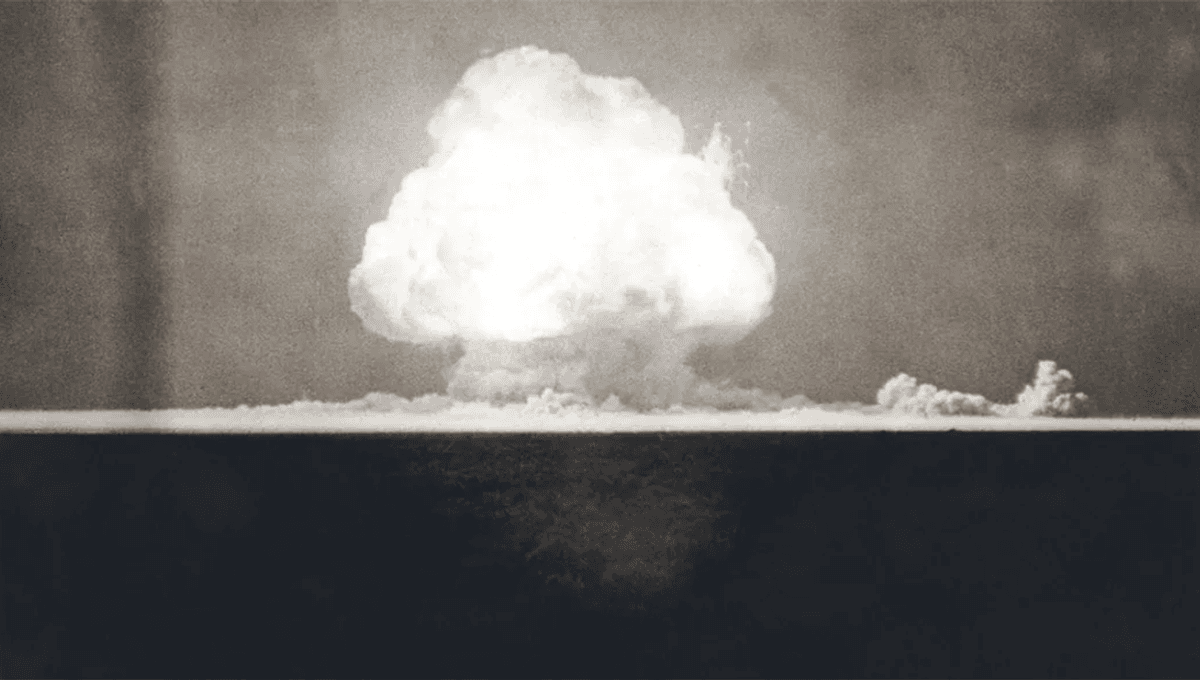
“When I came to you with those calculations, we thought we might start a chain reaction that might destroy the entire world,” J. Robert Oppenheimer says to Albert Einstein at the end of Oppenheimer and the beginning of many Oppenheimer remixes. “What of it?” Einstein asks, to which Oppenheimer replies “I believe we did.”
Oppenheimer is talking metaphorically, of course, referring to a world beginning to arm itself to the teeth with weapons that could destroy the world many times over. But before the first nuclear bomb was launched, as referenced in the film, physicists were concerned that the blast could set the atmosphere on fire, and literally destroy the world.
Key concerns, raised by theoretical physicist Edward Teller at a recruitment meeting in California, were that a reaction may become sustained, as it is in the Sun.
“The fear of Teller was that a fission bomb’s detonation process might involve rapid local heating of the atmosphere in which,” a new paper on the topic outlines, “because of a possible lack of cooling capability, the temperature might rise to such a point that the 14N nitrogen nuclei in the atmosphere might fuse with each other or with other light atmospheric isotope components, such as 1H hydrogen, 12C carbon, or 16O oxygen.”
The Manhattan Project had the foremost physicists of the time to figure it out. In 1942, Oppenheimer took a train to see Arthur Compton, Nobel Prize winner and expert in radiation physics, to try and get some answers. Or at least, the best answers available without experimental data (blowing up a big bomb and seeing if the planet sets on fire).
Compton remembered the meeting years later, and spoke about Oppenheimer’s fears.
“Hydrogen nuclei,” Arthur Compton explained to American Weekly in 1959, “are unstable, and they can combine into helium nuclei with a large release of energy, as they do on the sun. To set off such a reaction would require a very high temperature, but might not the enormously high temperature of the atomic bomb be just what was needed to explode hydrogen?”
There was also the possibility that the same thing could happen in the oceans.
“And if hydrogen, what about hydrogen in sea water? Might not the explosion of the atomic bomb set off an explosion of the ocean itself? Nor was this all that Oppenheimer feared. The nitrogen in the air is also unstable, though in less degree. Might not it, too, be set off by an atomic explosion in the atmosphere?”
This, of course, while ending the war, would do so a little too permanently, given that man, woman, and fish would be killed in the resulting reaction.
“It would be the ultimate catastrophe,” Compton continued. “Better to accept the slavery of the Nazis than to run the chance of drawing the final curtain on mankind.”
Compton, however, told Oppenheimer that it would not occur in atmospheric conditions. Radiation cooling would always be too fast for such a reaction to be sustained, as Teller later wrote a report classified until 1979.
“The energy losses to radiation always overcompensate the gains due to reactions,” he wrote in the report, adding “It is impossible to reach such temperatures unless fission bombs or thermonuclear bombs are used which greatly exceeds the bombs now under consideration.”
We now know through experimental data, including tests that forged “forbidden” quasicrystals, that sustained reactions in the oceans and atmosphere are not triggered by nuclear explosions. However, as the new paper written by Michael Wiescher and Karlheinz Langanke points out, the initial teams missed a key reaction. Though they had been concerned by 14N the most, given nitrogen’s abundance in the atmosphere, they did not consider the 14N(n,p)14C reaction, which produced 14C in abundance.
“The radiocarbon peak in our atmosphere decreases quickly because this long-lasting carbon isotope gets absorbed by plants through the carbon cycle. As a result, it becomes a part of all biological materials for thousands of years,” the team concludes. “This radiocarbon remains in our bodies, serving as a lasting reminder of the human hubris leading to the development of nuclear weapons that Oppenheimer wanted to caution against.”
The paper is published in Natural Sciences.
Source Link: "The Ultimate Catastrophe": Can A Bomb Set The Atmosphere On Fire?